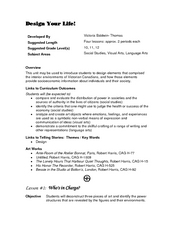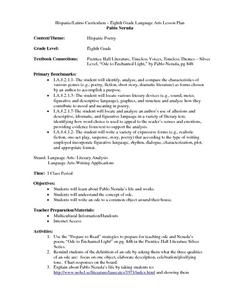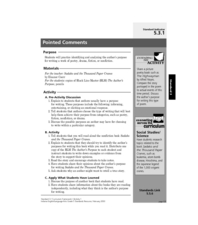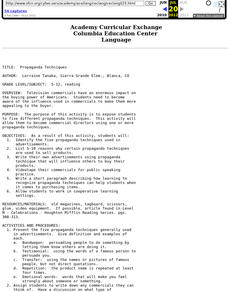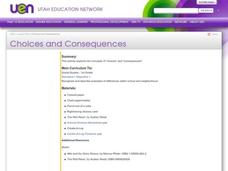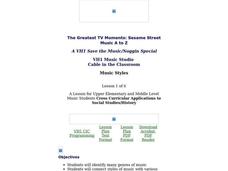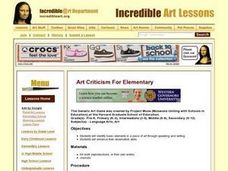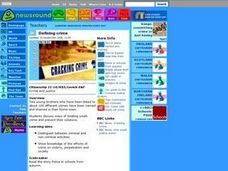Curated OER
The Classical Period
Sixth graders are introduced to the classical period in music history. After listening to examples, they identify and describe the characteristics of music during this time period and research the main composers. Using the internet,...
Curated OER
Problem and Solution Lesson
Students explore problems and solutions in literature. In this literature lesson, students identify problems and solutions in short guided and independent reading samples. Students also discuss characterization techniques used to develop...
Curated OER
Health Fair
Students identify and research the aspects of a healthy lifestyle and create a Health Fair with the information. In this healthy living lesson, students research a topic about healthy living. Students then create a health fair using...
Curated OER
Design Your Life
Students use three different pieces of art and identify the power struggles that are being represented. In groups, they use the Internet to research the distribution of wealth throughout Canada during the Victorian time period. They...
Curated OER
Pablo Neruda
Eighth graders explore the life and works of Pablo Neruda. They complete an author map concerning his personal and professional life. Students identify the key components of an ode. They write an ode to a common object around their...
Curated OER
"Phil"-ing Good
Students examine what it means to help their community. In this philanthropy lesson, students watch a video and read a book that give examples of philanthropic acts. Students make a list of these acts and discuss the emotions these...
Curated OER
Understanding Nouns
Students identify types of nouns. In this grammar lesson, students define what a noun is and identify the various types of nouns in sentences. This grammar lesson is geared towards Special Education students.
Curated OER
Railroad Advertising: Let's Go for a Ride!
Young scholars examine advertising from early to mid twentieth century. In this advertising techniques lesson, students assess the different ways advertisers "sold" the concept of railroad travel. Young scholars examine a...
Curated OER
Symmetry in Butterflies
Young scholars create a butterfly displaying a mirror image of itself to show that it is symmetrical. For this symmetry lesson plan, students go over symmetry in different shapes and identify patterns in butterflies.
Curated OER
Pointed Comments
Fifth graders analyze pieces of writing to identify the author's purpose of writing. In this writing lesson plan, 5th graders consider a variety of pieces of writing such as, poetry, drama, fiction, and non-fiction. Each student...
Curated OER
Propaganda Techniques
Young scholars identify five propaganda techniques used in advertisements, then write their own ads using propaganda techniques that influence others to buy their products. They videotape their commercials, and write about recognizing...
Curated OER
Choices and Consequences
First graders read "The Red Racer" by Audrey Wood. They identify choices and consequences present in the story. They identify and evaluate choices, and the consequences of those choices, in everyday life both at school and home.
Curated OER
All About Me: My Senses
Students explore the world around them and identify their five senses and the parts of their bodies that are associated with each sense.
Curated OER
Music Styles
Young scholars identify many genres of music and connect styles of music with various cultures. They watch "The Greatest TV Moments: Sesame Street Music A to Z" and list music styles: folk, jazz, rock, etc.
Curated OER
Andersonville National Historic Site
Learners describe the conditions of a prisoner of war camp during the Civil War. They analyze ways in whcih the soldiers dealt with prison life. They identify the location of any nearby prisoner of war camps.
Curated OER
Dealing With Bullies
Learners identify bullying behaviors and identify strategies for dealing with bullies. They participate in role-plays and discuss the experience later as a group. After role-playing scenarios provided by the teacher, students create...
Curated OER
Language Arts: Lewin Project
Fourth graders read and respond to the poem, "When I Am Angry." They complete surveys by analyzing the most common feeling and draw a bar graph of their behavior, using different colors to identify the duration of various feelings. ...
Curated OER
Art Criticism for Elementary
Students view various pieces of art and identify their basic elements. Using the art, they present the elements to the class in a presentation. They answer questions and organize them into written form. They also write and reflect on...
Curated OER
Crime and Young People
High schoolers read the story, "Police in Schools". They view a list of common offences committed by young people and identify the victims of these offences and consider how the offence would affect those people.
Curated OER
Help Wanted: A Lighting Engineer For Popular Rock Group
Students are assigned to groups, and determine each member's role in the group. They will design an experiment to determine a way to produce the three primary and five secondary colors. Students discuss color and mood. They listen to a...
Curated OER
Music Storytellers
Pupils identify the quality and effectiveness of musical performances through the use of music telling a story. They will compare and contrast philosophy and form of song segments.
Curated OER
Using Literature as a Tool to end Name Calling
Students use bibliotheraphy or the guided use of books to help solve problems. They support targets of bullying as they express their feelings and learn coping strategies. By using books, students can then identify, catharsis and have...
Curated OER
The Parts of an Editorial
Learners take notes as the teacher goes over the contents of an editorial and four types of an editorial. Students view an editorial and identify the structural elements in the sample as well as identify the type of editorial they are...
Curated OER
Language Arts: The Three Appeals
Students are able to identify and describe the persuasive techniques used in editorial writing. They are able to label persuasive techniques with the logos, pathos, and ethos terminology.



